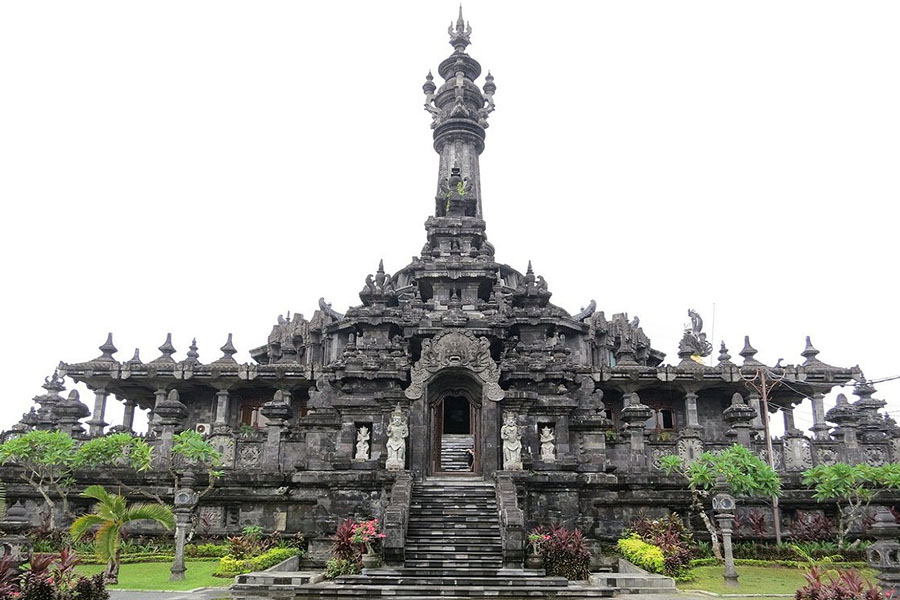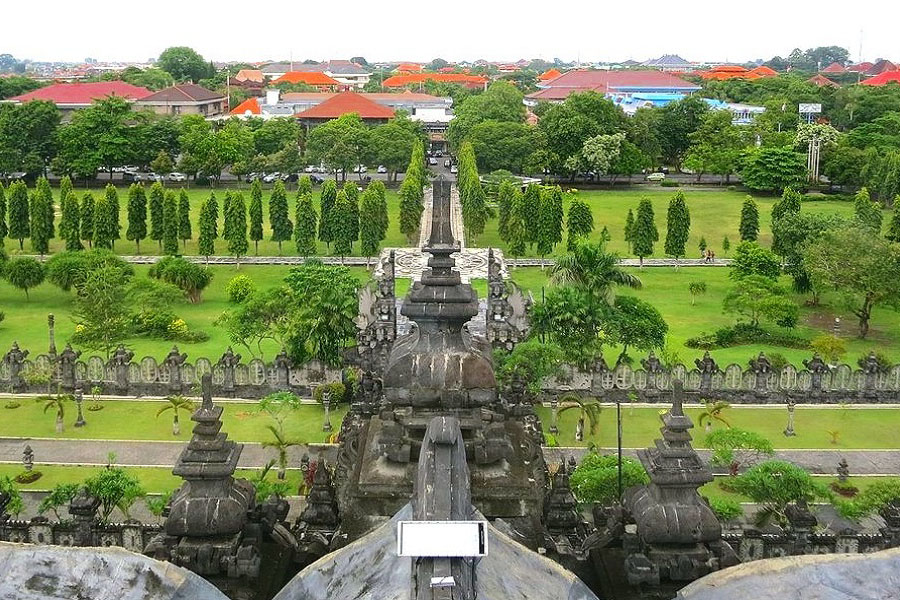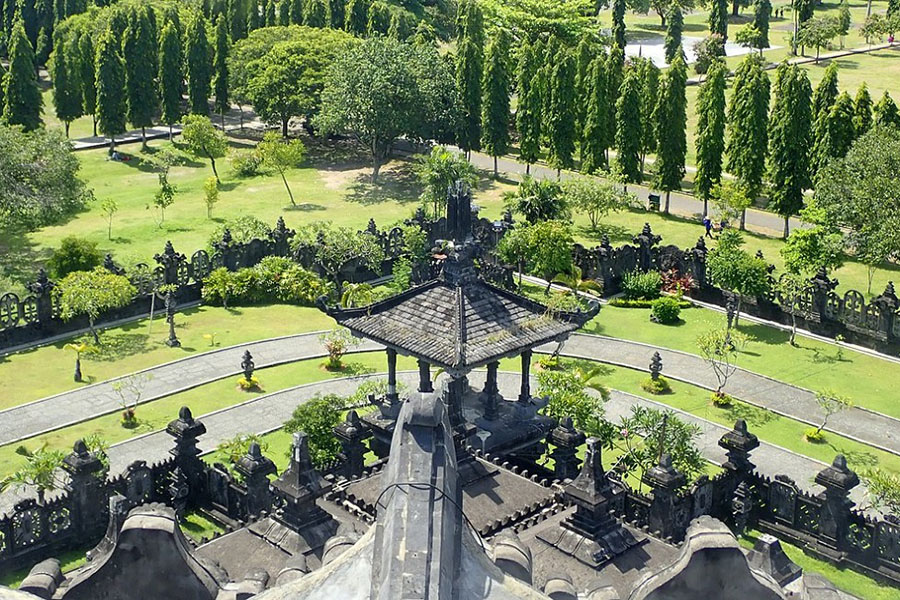BALI BAJRA SANDHI MONUMENT
BALI BAJRA SANDHI MONUMENT IS A MONUMENT OF BALINESE PEOPLE STRUGGLE

The Bajra Sandhi Monument is a monument to the Balinese People’s Struggle. The name “Bajra Sandhi” was chosen because of its shape, which resembles a Bajra (Genta), or a bell used by Hindu priests when chanting sacred mantras (Weda) in religious ceremonies. The monument was built in 1987 and opened by President Megawati Soekarno Putri on June 14, 2003. Since it was inaugurated, this monument has become a place that is often visited by visitors because of its strategic location in the center of Denpasar. It is located on the Renon Field, where this field is often used by the public for sports. The building of the majestic Bajra Sandhi monument exudes Balinese distinctiveness through its design, which is full of stunning carvings on every side. With the large park surrounding it, this monument is a popular tourist destination in Denpasar, with both foreign and domestic tourists coming to enjoy the uniqueness of the monument.
If you visit Bajra Sandhi Monument, here’s what you need to know:
- Purpose of Bajra Sandhi Monument
- The Beginning of Bajra Sandhi Monument
- Bajra Sandhi Monument Philosophy
- Bajra Sandhi Monument Building
- Bajra Sandhi Monument Facilities
- “I Am Bali” 3D Museum at Bajra Sandhi Monument
Purpose of Bajra Sandhi Monument
If we talk about the purpose of the Bajra Sandhi Monument, we will refer to the history of the struggle of the Balinese people in the past. At that time, Bali, like many regions in Indonesia, also experienced colonization by foreign nations. Heroes like I Gusti Ngurah Rai and I Gusti Ketut Pudja became the main figures in the resistance against the colonizers. They fought relentlessly, sacrificing themselves for justice, such as in the Puputan Jagaraga battle (1848-1849), the Banjar people’s resistance (1868), the Puputan Badung war (1906), the Klungkung war (1908), and the Puputan Margarana war (1946). To keep this history remembered by the next generation, the government immortalized the names of these heroes on roads, airports, and other places. This step is taken so that future generations do not forget the sacrifices and struggles made by the heroes for Indonesia’s independence.
The award also serves as a means for the younger generation to learn and emulate the spirit of sacrifice, love for the country, and unity shown by the figures in gaining independence for Indonesia. One of the greatest efforts to perpetuate these values was to build the Bajra Sandhi Monument located on the Renon Field, which is also known as the Balinese People’s Struggle Monument. The purpose of the Bajra Sandhi Monument is to respect and inherit the spirit of the Balinese people’s struggle while strengthening, caring for, developing, and preserving the Balinese cultural heritage. This is done so that these values can be passed on to the next generation, who will face challenges and struggles in the future.

The Beginning of Bajra Sandhi Monument
Starting from the initiative of Prof. Ida Bagus Mantra when he served as Governor of Bali, a competition was held for ideas and designs for the construction of the Bajra Sandhi Monument. The winner was Ida Bagus Yadnya, who at the time was a student at Udayana University. In August 1988, a groundbreaking ceremony was held to mark the start of the monument construction project. The construction process of the Bajra Sandhi Monument took quite a while because it faced various obstacles, especially budget issues due to the monetary crisis at the time. Construction was halted but then resumed. In 2003, the building project was successfully completed and inaugurated by President Megawati Soekarno Putri. Since then, many have admired the design of this monument and made it one of the Denpasar places of interest that can be visited as a place for selfies, recreation, and gathering with relatives or family. With its strategic position, the Bajra Sandhi Monument can be seen clearly from the highway around the Puputan Field, and from a distance, the beauty is mesmerizing.
Bajra Sandhi Monument Philosophy
The Balinese People’s Struggle Monument has many philosophies behind its construction. One of them is the Linga-Yoni Philosophy, which symbolizes fertility and prosperity through the meeting of the Linga symbol, representing Purusa (male), and Yoni, representing Pradana (female). According to Mr. Nyoman Subawa, the monument was also inspired by the philosophy of the Adi Parwa Book, particularly the story of Mandara Giri (Mount Mandara), which plays in Ksirarnama (Sea of Milk). The story tells of the efforts of the Gods and Giants (Daitya) in search of Tirta Amertha (the water of eternal life) by circling Mount Mandara. The process of circling Mount Mandara symbolizes the obstacles that must be faced, where the gods hold the tail of the Besuki dragon, which symbolizes the ropes and twists of the mountain, while the Daitya holds its head. Lord Shiva himself bears this burden by occupying the top of the mountain to guard the base of Mount Mandara in the form of an Akupa (turtle). Through the struggles and obstacles faced, they finally managed to get various results, such as the release of Ardha Candra (Crescent Moon), Dewi Sri and Laksmi, Uchaisrawah Horse (Flying Horse), Kastuba, Mani (Tree of Happiness), and finally Dewi Dhanwantari, who brought Tirta Amertha.
Philosophically, the story teaches the younger generation about the importance of working hard, persevering, and working together to achieve success. This message is reflected in the struggle of the gods and giants in the story of Mandara Giri, which shows that with fortitude and cooperation, all obstacles can be overcome to achieve the desired goal. In addition to Hindu philosophical values, the Bajra Sandhi Monument also implies symbols of Indonesian independence. For example, there are 17 steps at the main entrance of the monument. In addition, there are 8 magnificent pillars inside the monument, whose height of 45 meters also reflects the moment of independence. These symbolically represent the date of Indonesia’s independence, which was August 17th, 1945. All these symbols are a reminder of the values of independence, hard work, and unity that are the basis for the nation’s glory.

Bajra Sandhi Monument Building
The shape of the Bajra Sandhi Monument is designed to resemble the Bajra (clapper), or sacred bell (sandhi) used in religious ceremonies by Hindu priests in Bali. The name “Bajra Sandhi” was chosen because of its Bajra-like shape. In our opinion, this name is very appropriate because this monument impresses with splendor and, when seen for the first time, gives a very majestic impression. One of the interesting things at the Bajra Sandhi Monument is the diorama, which consists of 33 units that describe the history of Bali, starting from the Prehistoric Age, Historical Age, Ancient Bali Age, Middle Bali Age, Colonial Age, and Old Age. The diorama is displayed in three dimensions, complete with human statues, animals, and other elements that explain the history of Bali. The goal is for visitors to understand and learn about the conditions and situation of Bali at that time, so that the spirit and culture of Bali can be maintained and improved and become an attraction for Bali tourism. The physical building of the Bajra Sandhi Monument has a close relationship with Hindu philosophy, especially the giant Yoni, which symbolizes the base of the building. Symbolically, this colossal Yoni also depicts the twirling story of Mandhara Giri in Ksirarnawa, taken from the Hindu Adi Parwa Scripture. This adds deep meaning to the Bajra Sandhi Monument. The Bajra Sandhi Monument building consists of several main parts that include:
- The jar that symbolizes Amertha, represented by Kumba (a type of pot), is seen at the top of the monument.
- The Dragon Basuki’s tail is located near the Swamba, and its head is at the entrance gate.
- The body of Bedawang Akupa is realized at the base of the monument, while its head is at the entrance gate.
- Mount Mandara Giri is realized by the elevation of the monument.
- The pool encircling the monument is interpreted as Ksirarnawa, or the milk ocean.
Bajra Sandhi Monument Facilities
Bajra Sandhi Monument has very complete facilities, which are located in a strategic location on the Niti Mandala Renon Field, in Denpasar city center. Around the monument, there is a large parking area and a field that is often used for exercise by the community. There are many food and beverage vendors around the area, as well as restrooms for the convenience of visitors. With these complete facilities, you should not hesitate to visit the Bajra Sandhi Monument. This monument has been opened to the public and has become one of the most interesting tourist destinations in Bali, especially for those visiting Denpasar. You can also join the Bali Denpasar City Tour Package provided by Bali Exotic Tour to visit this beautiful place. With all its uniqueness and splendor, the Bajra Sandhi Monument is worth a visit while in Denpasar or heading to Ubud.
“I Am Bali” 3D Museum at Bajra Sandhi Monument
There is something very interesting if you visit the Bajra Sandhi Monument, which is the I Am Bali 3D Museum on its lower floor. This museum offers a unique experience in the form of three-dimensional photographs with various designs, such as human figures, nature, animals, buildings, birds, and others. This experience will definitely make you feel at home and entertained in this museum because you can take pictures with an interesting 3D sensation. When you enter the museum, you will be asked to wear socks to keep the floor clean. However, there is no need to worry because the museum provides socks that you can buy if you don’t bring your own. Visiting the Bajra Sandhi Monument and getting to know its history, followed by visiting this fantastic 3D museum, will definitely be a very fun and memorable experience for you.

